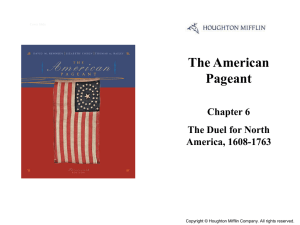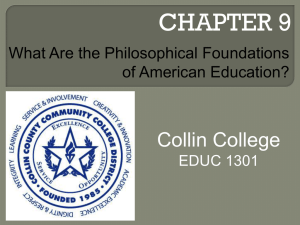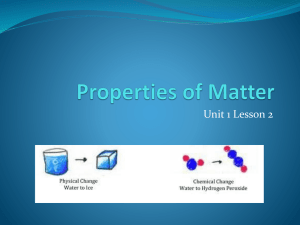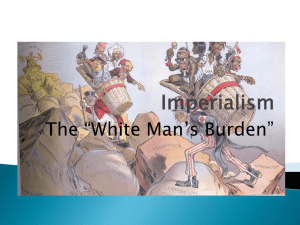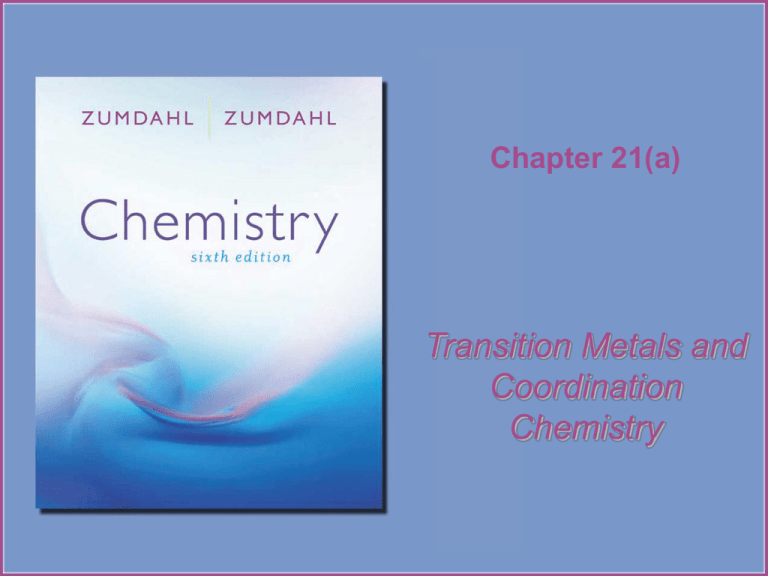
Chapter 21(a)
Transition Metals and
Coordination
Chemistry
Copyright © Houghton Mifflin Company. All rights reserved.
21a–2
Figure 21.1: The position of the transition elements
on the periodic table.
The transition metals.
Copyright © Houghton Mifflin Company. All rights reserved.
21a–4
Wulfenite contains PbMoO4.
Copyright © Houghton Mifflin Company. All rights reserved.
21a–5
Rhodochrosite is a mineral containing
MnCO3.
(From left to right) Metals containing the
2+
2+
3+
3+
2+
metal ions CO , Mn , Cr , Fe , and Ni .
Copyright © Houghton Mifflin Company. All rights reserved.
21a–7
Copyright © Houghton Mifflin Company. All rights reserved.
21a–8
Figure 21.2: Plots of the first (red dots) and
third (blue dots) ionization energies for the
first-row transition metals.
Copyright © Houghton Mifflin Company. All rights reserved.
21a–9
Copyright © Houghton Mifflin Company. All rights reserved.
21a–10
Figure 21.3: Atomic radii of the 3d, 4d, and
5d transition series.
Copyright © Houghton Mifflin Company. All rights reserved.
21a–11
3+
Ti(H2O)6
is purple in
solution
Copyright © Houghton Mifflin Company. All rights reserved.
21a–13
Copyright © Houghton Mifflin Company. All rights reserved.
21a–14
Copyright © Houghton Mifflin Company. All rights reserved.
21a–15
Chapter 21(b)
Transition Metals and
Coordination
Chemistry (cont’d)
Figure 21.4: The structures of the chromium(VI)
2anions: (a) Cr2O7 , which exists in acidic solution,
2and (b) CrO4 , which exists in basic solution.
Copyright © Houghton Mifflin Company. All rights reserved.
21a–18
An aqueous
solution
containing the
2+
Ni ion.
Copyright © Houghton Mifflin Company. All rights reserved.
21a–20
Copyright © Houghton Mifflin Company. All rights reserved.
21a–21
Copyright © Houghton Mifflin Company. All rights reserved.
21a–22
Copyright © Houghton Mifflin Company. All rights reserved.
21a–23
Copyright © Houghton Mifflin Company. All rights reserved.
21a–24
Figure 21.5:
The ligand
arrangements
for
coordination
numbers 2, 4,
and 6.
Figure 21.6:
(a) The bidentate
ligand
ethylenediamine
can bond to
the metal ion
through the lone
pair on each
nitrogen atom,
thus forming two
coordinate
covalent bonds.
(b) Ammonia is a
monodentate
ligand.
Copyright © Houghton Mifflin Company. All rights reserved.
21a–27
Figure 21.7:
The
coordination
of EDTA
with a 21
metal ion.
Copyright © Houghton Mifflin Company. All rights reserved.
21a–29
Copyright © Houghton Mifflin Company. All rights reserved.
21a–30
Chapter 21(c)
Transition Metals and
Coordination
Chemistry (cont’d)
(top)An aqueous
solution of
[Co(NH3)5CI]CI2.
(bottom) Solid
K3Fe(CN)6
Figure 21.8: Some classes of isomers.
Copyright © Houghton Mifflin Company. All rights reserved.
21a–33
Figure 21.9: As
a ligand, NO2can bond to a
metal ion (a)
through a lone
pair on the
nitrogen atom or
(b) through a
lone pair on one
of the oxygen
atoms.
Figure 21.10:
(a) The cis
isomer of
Pt(NH3)2Cl2
(yellow). (b)
The trans
isomer of
Pt(NH3)2Cl2
(pale yellow).
Figure 21.11: (a) The trans isomer of
+
[Co(NH3)4Cl2] . (b) The cis isomer of
+
[Co(NH3)4Cl2] .
Figure 21.12: Unpolarized light consists of waves
vibrating in many different planes (indicated by the
arrows). The polarizing filter blocks all waves
except those vibrating in a given plane.
Copyright © Houghton Mifflin Company. All rights reserved.
21a–37
Figure 21.13: The rotation of the plane of
polarized light by an optically active
substance. The angle of rotation is called
theta ().
Copyright © Houghton Mifflin Company. All rights reserved.
21a–38
Figure 21.14: Some cis complexes of
platinum and palladium that show significant
antitumor activity.
Copyright © Houghton Mifflin Company. All rights reserved.
21a–39
Figure 21.15: A human hand exhibits a nonsuperimposable
mirror image. Note that the mirror image of the right hand
(while identical to the left hand) cannot be turned in any way
to make it identical to (superimposable on) the actual right
hand.
Copyright © Houghton Mifflin Company. All rights reserved.
21a–40
Figure 21.16: Isomers I and II of Co(en)33+ are mirror
images (the image of I is identical to II) that cannot be
superimposed. That is, there is no way that I can be turned
in space so that it is the same as II.
Copyright © Houghton Mifflin Company. All rights reserved.
21a–41
Figure 21.17: (a) The trans isomer of Co(en)2Cl2+ and its
mirror image are identical (superimposable). (b) The cis
isomer of Co(en)2Cl2+ and its mirror image are not
superimposable and are thus a pair of optical isomers.
Copyright © Houghton Mifflin Company. All rights reserved.
21a–42
Figure 21.18: A set of six d2sp3 hybrid
3+
orbitals on Co can accept an electron pair
from each of six NH3 ligands to form the
3+
Co(NH3)6 ion.
Figure 21.19:
The hybrid
orbitals required
for tetrahedral,
square planar,
and linear
complex ions.
Figure 21.20: An octahedral arrangement of
point-charge ligands and the orientation of
the 3d orbitals.
Copyright © Houghton Mifflin Company. All rights reserved.
21a–45
Chapter 21(d)
Transition Metals and
Coordination
Chemistry
Figure 21.21: The energies of the 3d orbitals
for a metal ion in an octahedral complex.
Copyright © Houghton Mifflin Company. All rights reserved.
21a–47
Figure 21.22: Possible
electron arrangements
in the split 3d orbitals
in an octahedral
complex of Co3+
(electron configuration
3d6). (a) In a strong
field (large ∆ value),
the electrons fill the t2g
set first, giving a
diamagnetic complex.
(b) In a weak field
(small D value), the
electrons occupy all
five orbitals before any
pairing occurs.
Figure 21.23: The visible spectrum.
Copyright © Houghton Mifflin Company. All rights reserved.
21a–49
Figure 21.24:
(a) When white light
shines on a filter
that absorbs in the
yellow-green region,
the emerging light is
violet. (b) Because
the complex ion
Ti(H2O)63+ absorbs
yellow-green light, a
solution of it is
violet.
Copyright © Houghton Mifflin Company. All rights reserved.
21a–51
Figure 21.25: The complex ion Ti(H2O)63+
can absorb visible light in the yellow-green
region to transfer the lone d electron from the
t2g to the eg set.
Copyright © Houghton Mifflin Company. All rights reserved.
21a–52
Copyright © Houghton Mifflin Company. All rights reserved.
21a–53
Solutions of [Cr(NH3)6]CI3 (yellow) and
[Cr(NH3)5CI]CI2 (purple)
Copyright © Houghton Mifflin Company. All rights reserved.
21a–54
Figure 21.26: (a) Tetrahedral and octahedral
arrangements of ligands shown inscribed in
cubes.(b) The orientations of the 3d orbitals relative
to the tetrahedral set of point charges.
Copyright © Houghton Mifflin Company. All rights reserved.
21a–55
Figure 21.27: The crystal field diagrams for
octahedral and tetrahedral complexes.
Copyright © Houghton Mifflin Company. All rights reserved.
21a–56
Figure 21.28: (a)
The crystal field
diagram for a
square planar
complex oriented
in the xy plane with
ligands along the
x and y axes.
(b) The crystal field
diagram for a linear
complex where the
ligands lie along
the z axis.
Copyright © Houghton Mifflin Company. All rights reserved.
21a–58
Figure 21.29:
The heme
complex, in
2+
which an Fe
ion is
coordinated to
four nitrogen
atoms of a
planar porphyrin
ligand.
Figure 21.30: Chlorophyll is a porphyrin
2+
complex of Mg . There are two similar forms
of chlorophyll, one of which is shown here.
Copyright © Houghton Mifflin Company. All rights reserved.
21a–60
Chapter 21(e)
Transition Metals and
Coordination
Chemistry
Figure 21.31: A representation of the
myoglobin molecule.
Copyright © Houghton Mifflin Company. All rights reserved.
21a–62
Figure 21.32: A representation of the
hemoglobin structure.
Copyright © Houghton Mifflin Company. All rights reserved.
21a–63
Figure 21.33: A normal red blood cell (right)
and a sickle cell (left), both
magnified 18,000 times.
Copyright © Houghton Mifflin Company. All rights reserved.
21a–64
Copyright © Houghton Mifflin Company. All rights reserved.
21a–65
Figure 21.34: A schematic diagram of a
cyclone separator.
Copyright © Houghton Mifflin Company. All rights reserved.
21a–66
Figure 21.35: A schematic representation of
zone refining.
Copyright © Houghton Mifflin Company. All rights reserved.
21a–67
Copyright © Houghton Mifflin Company. All rights reserved.
21a–68
Figure 21.36:
The blast
furnace used
in the
production of
iron.
Figure 21.37: A schematic diagram of the
open hearth process for steelmaking.
Copyright © Houghton Mifflin Company. All rights reserved.
21a–70
Figure 21.38:
The basic
oxygen
process for
steelmaking.
Copyright © Houghton Mifflin Company. All rights reserved.
21a–72


